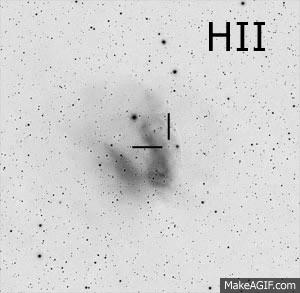Sh2-174 The planetary nebula abandoned by its central star?
Cepheus
23 46 49
+80 56 20
Type: Planetary nebula (?), 10'x15'
Sharpless 174 has a size of about 10'x15' and belongs hence to the very large planetary nebula. Its central star has a relatively large proper motion. During its movement through the interstellar matter, the PN looses part of its shell which is left behind as a trail visible in HII light. The central star is therefore no longer in the center of the HII-emitting part of the PN.
Image by Stephane Zoll in HII and OIII
Sharpless174_Zoll.jpg
Due to the apparent lack of a central star (there was no suitable start in the HII part of the nebula), Sh2-174 was first classified as an HII region. The part of the nebula, that shines in OIII light is, however, concentric around a White Dwarf, which gave evidence for Sharpless 174 being a PN. The parts of this object that are visible in HII and OIII light appear therefore slightly displaced (see animation below).
RW Tweedy, R Napiwotzki, The planetary nebula abandoned by its central star
OIII and HII frames of Sh2-174
My observations of this object
This displacement is visible at the eyepiece. The PN is quite faint, but still bright enough to allow for a detection of the slight displacement when switching from H beta to OIII filter. The disk of the PN appears diffuse without clear edges. OIII emission is displaced to the NW, while H beta and hence HII emission is more extended and displaced towards SE, in agreement with the narrow band images. Using an UHC filter, both components appear simultaneously, yielding a round appearance of the PN.
New interpretation of the nature of Sharpless 174
Entering David Frew, Dep. of Physiscs at Macquarie University in Sydney. During his PhD time, the made a survey of the nearby PN and PN candidates, gathering new data and re-examining existing data. One of his aims was to set up a new distance scale for PN and to prepare a sample of all known *bona fide* PN nearer than 1000 pc. Such a sample would allow examination of PN also with statistical tools and, of course, be to the delight of us amateuer astronomers, providing us a new observing project :-).
Thesis of David Frew
While there were not that many new PN to add to the sample of true PN, there were several, formerly acknowledged PN to be rejected from the sample. One of them was Sharpless 174. So, what's the point of rejecting Sharpless 174 from being a true PN after the reason for its peculiar appearance and for the apparent lack of a CS seemed to be solved?
The first point is the White Dwarf star. It is cooler than other WD of evolved PN of similar age and did not fit into the typical post-AGB scenario of a PN central star. The WD is simply by a factor of 100x too old for being a PN central star.
The nebula itself shows several features that are not in line with it being a PN.
a) The line shifts of the nebula indicate no co-movement of the gas with the White Dwarf
b) There is no obvious limb brightening of the nebula which would be expected for a shell ejected in the PN formation phase (as compared with a solid sphere of gas)
c) There is no bowshock of the nebula in direction of the movement of the White Dwarf (going along with a). Also a low ionization NII rim preceeding the nebula is missing. Such a bow shock would be expected if the highly diluted material of the evolved PN would interact with the interstellar medium (as it does for other evolved PN of similar age).
David Frew ends up with the notion: Sharpless 174 is not a PN shell (i.e. material ejected by the CS at the end of its AGB phase) but a Strömgren sphere, i.e. unrelated interstellar medium excited by the moving White Dwarf. The "shift" of the OIII and HII zones and the lag of the HII zone results from the higher recombination time of HII as compared with OIII (explaining also the tail in the similar nebula Sharpless 68).
This makes entirely sense and even it this were not the last word on Sharpless 174, it does not diminish the fun of hunting this obscure object. The statement "I have observed the shifted Strömgren spheres of a White Dwarf" is at least as cool as " I have observed an old PN", isn't it?
There are a few more "famous" PN that could be mere Strömgren spheres, such as Sharpless 68, DeHt 5, TK 2 or even Abell 35.
“Give it a go and let us know!”
Good luck and great viewing!





 Reply With Quote
Reply With Quote




